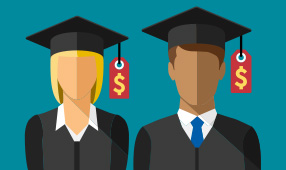Key takeaways
- Organize and itemize your debts and then focus on paying down one account at a time.
- Use the snowball method to pay off your smallest debt and bask in the positive reinforcement.
- Balance your debt payments against your retirement savings needs for overall financial wellness.
Bryce is typical of many young working Americans. He has three credit cards and two of them have balances that are accruing interest. He also has a car payment and a student loan. Every time he sends his hard-earned money out to creditors he dreams wistfully of the freedom he’d feel if he could at least eliminate the credit card debts. “But where do I start?” he asks.
Organize your debts
Personal finance experts have developed some tried and true debt-elimination strategies that start with a little debt analysis and housekeeping.
- Avoid adding more debt. If you want to lose weight, you don’t eat more calories, right? Same with losing the debt. Put your credit cards on hiatus (and certainly don’t apply for any new cards or loans). Use a debit card for purchases instead. This forces you to spend only the money you actually have in the bank.
- Itemize current debts. Write down the balance, interest rate and minimum payment due on each account. (You don’t need to include the primary mortgage on your home unless you would like to pay it off early.) Add up your minimum payments that must be made each month, then figure out how much more you have available to help reduce the principal. Minimum payments just keep your account current with interest owed. They don’t help reduce the principal which extends the term of the loan.
- Focus on one account at a time. This is your core strategy in paying off debts. You’ll apply all the money you have beyond the minimum payment obligations to just one debt. Logic—and math—will dictate that you focus on paying off the debt with the highest interest rate first. The sooner you get that paid off, the less interest charges you’ll pay and the more money you’ll have to pay off your other debts. This is the quickest way to pay down debt, and it makes a lot of sense for highly motivated people. But if you’re not in the highly motivated camp, financial guru Dave Ramsey suggests thinking about snowballs.
Using snowballs to pay down debts
People aren’t always rational, and often motivation gets rationalized away. Think about when you try to break a bad habit. Positive reinforcement really helps push you to the finish line.
The same principle applies to getting yourself out of debt and on the path to financial freedom. That’s why Ramsey recommends the snowball method. Pick your smallest debt and pay that down first. Make only the minimum payments on your other accounts so you can apply all extra funds to that smallest debt.
Why? Because you’ll be able to pay off that small debt more quickly than any of the others. Not only will you feel a sense of accomplishment when that debt is history, you’ll be able to apply the minimum payment you were making on that debt, plus any extra available funds, to your next smallest debt, which you’ll now focus on until it too is paid off.
By the time you get to the third debt, you’ll be ready with the minimum payments you were making on the first two debts, plus any extra cash you can spare, to make even larger monthly payments and perhaps accomplish an even quicker debt disappearing act.
As your monthly payments are growing larger—think snowball rolling down the hill— your debts will be shrinking ever smaller.
Ramsey says that the positive reinforcement of seeing debts disappear is worth more than tackling a large, higher-interest debt with monthly payments that feel like they’re not even making a dent.
If you have two debts that are more or less equal in amount, you should tackle the one with the higher interest rate first.
Sprinkle snowflakes to grow your payment snowball
One way to make that “snowball” grow even faster is to add the “snowflake” method to your strategy. Do everything possible to increase the amount you can pay toward your debt each month by finding some extra cash:
- Streamline your cable TV package
- Ask lenders if they have incentive discounts, such as auto pay
- Demand a better deal from your wireless provider
- Calculate if you could afford to increase some insurance deductibles to help lower premiums
- Sell items online
- Hold a yard sale
- Find ways to earn some extra money
Take all this extra cash (“snowflakes”) and apply it your current top-priority debt. Make interim payments, if you can, to reduce the principal as quickly as possible. An extra $100 or $200 a month can quickly reduce your outstanding balance.
Remember your retirement savings strategies
Financial advisers are split on whether it’s prudent to accelerate your debt payments by cutting back on your retirement plan contributions.
Some say you should never reduce your retirement plan contributions because that money compounds tax-deferred, which is a big advantage for long-term growth potential. Others argue that increasing your debt payments to reduce those high interest charges might justify suspending retirement contributions for a short while, if it’s the only way you can do it. Just make sure you have the discipline to ramp up your retirement savings once your debt is under control.
How you work your retirement savings into your debt pay down strategies depends on the level of stress you’re feeling about your debts and how many years you have to build up retirement income.
If your debts feel like an anchor dragging behind your life boat, use these tips to methodically reel it in, get your finances back on course and sail towards the horizon with a satisfied smile on your face.












